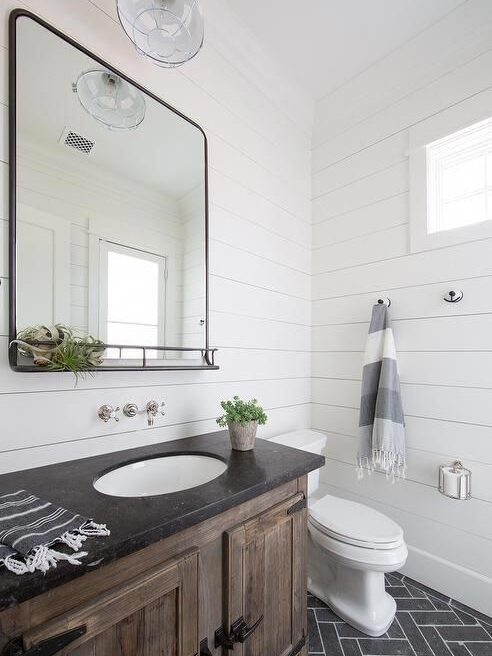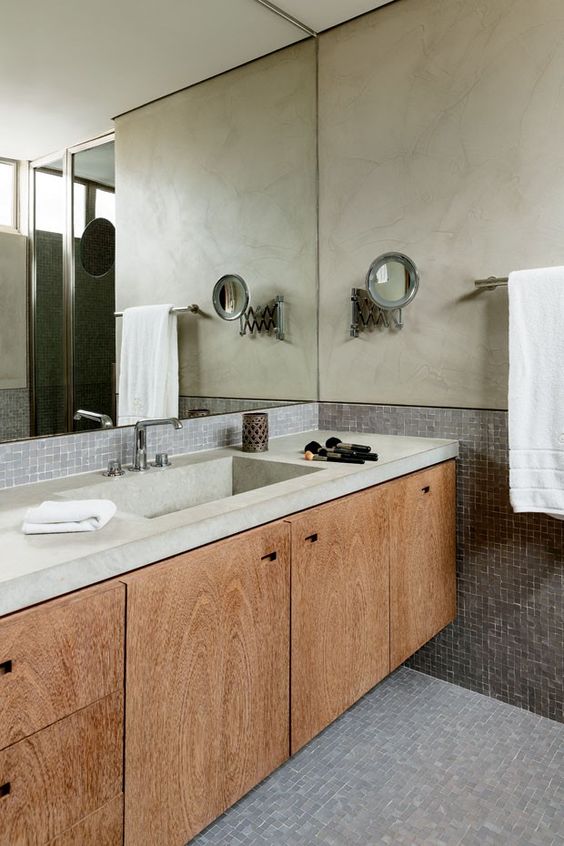Bathroom Countertop Materials: Laminate, Natural and Engineered Stones, Wood, Concrete…
Nowadays, there are so many material options for bathroom countertops that it can be quite a tricky choice. So, let’s compare the most common ones and analyze their pros and cons.
This article is about materials specifically. See our article on bathroom countertop design to read about dimensions, backsplashes, edge profiles and where to place the sink.
Page Contents:
Laminate bathroom countertops
A popular and inexpensive material for countertops, laminate is a sort of plastic layer that covers an MDF board, both protecting it from moisture and giving it basically any look you want.
Laminate patterns used to look fake and unappealing, but the options offered today are impressively real. There is a huge range of options and you can probably find something similar to any of the other materials we’ll see next.
Still, MDF is a lightweight material and to the touch it can feel quite hollow. It’s also just an imitation and a keen eye will quickly distinguish the difference, so you will never get the look and feel of a high end bathroom.
However, it’s a sensible option if your idea is doing it yourself, or you’re looking for a quick and cheap solution.


Natural stone bathroom countertops: Granite, Soapstone, Slate, Marble and Travertine
Stone is a great material for bathroom countertops, due to its beauty, durability and resistance (both to impact and to moisture).
The unique patterns formed on natural stones make them a stylish and luxurious choice.
However, they are usually more expensive than most materials and, depending on the stone, need more careful maintenance.
Also, many natural stones are porous so you have to be careful not to spill anything that will absorb into the material and leave a stain.
Many types of stone can be used, each one presenting different characteristics and prices:





Engineered stone bathroom countertops: Marmoglass, Nanoglass, Silestone, Corian and Quartz
Nowadays, there are several models of engineered stones. Unlike the stones we saw above, these are not natural materials: they are made of resin mixed with particles of glass, stone, acrylic or polyester.
The models available have a huge variety of colors and textures. Some of them imitate specific types of natural stones, with a more consistent patterning than natural pieces.
Therefore, they’re a good material choice if you prefer to control your bathroom countertop’s look and don’t like the idea of natural variations.
But keep in mind that engineered stones can look artifitial, because they are. The appearance is more realistic than the laminate, though. And the hardness is comparable to natural stone.
Compared to natural stones, these materials are easier to take care of and more resistant to stains, but not always to heat. Most of them can scorch if you support a hot pan on the countertop.
Prices vary a lot from type to type, being more or less in the same range as natural stones.





Wood bathroom countertops
Varnished, solid wood is resistant to sporadic splashing, so it can be used as a bathroom counter. The advantages are beauty and cozy texture.
Plenty of water, however, can damage the wood. In addition, it‘s an organic material, and therefore has variations in shade and designs, and may show stains over time due to moisture.
If you want a material that allows a constantly wet countertop and don‘t tolerate natural variations, better choose another material.
The varnish should be applied approximately once a year. The price of solid wood is high, so the countertop ends up being more expensive than one made of granite, for example.


Concrete bathroom countertops
Concrete countertops can be left exposed or covered with tiles.
The countertop is all built on site and takes time to build and dry.
A good part of the price will be for labor, so it can vary a lot. If you already have a construction team, you can probably get a better price.
Because it‘s a porous and fragile material, concrete bathroom countertops can end up breaking in corners. And it’s not possible to repair it. So this option is suitable for those who want a rustic look and don’t mind imperfections.
If the concrete is left apparent, be sure to apply a resin to decrease the permeability.


Replace your bathroom countertop with a sideboard
In order to create a unique and creative decor, it‘s possible to adapt a piece of furniture as a counter. It can be an old sideboard, to give a retro look, or a modern wooden furniture, for example.
Choose a piece of furniture that already has what you want to store things on the bottom: drawers, doors, shelves…
Remember to check its height, and choose the type of sink so that the total height is as close as possible to 85cm/2‘10″.
Having chosen the sink and the tap, check the position of the necessary holes and make the adjustment yourself or with the help of a joiner.


So these are the most recommended materials for bathroom countertops. Do you know your favorite yet?
Make sure to also check our article on bathroom countertop design, and find out the ideal dimensions, whether you should have a backsplash and an edge profile, and more details to make your countertop just as you like.
